- Intro
- What does “OKR” Stand For?
- Who Created the OKR Methodology?
- What are OKRs in Agile?
- Why are OKRs Essential for a Business?
- Industries and Companies that use OKRs
- What are the benefits of OKRs?
- How to Write Good OKRs
- How to Track OKR Results?
- OKR Examples
- Common OKR Mistakes
- How to Implement OKRs in your business?
- Benefits of an OKR Software
What is an OKR? The Ultimate Guide
Intro
OKRs have been popular with tech companies since their inception, and are now more broadly used across various industries. This metric system defines company objectives along with the key results that are needed to measure the achievement. A good reference word for OKRs would be ‘Achieve’.
What does “OKR” Stand For?
OKR stands for Objectives and Key Results, and they are a collaborative goal-setting process used to set ambitious goals that have measurable results. With OKRs, you can track the progress of your team, align them towards the same objective, and even drive engagement.
OKRs continue to be a hot topic, now more than ever given the current climate of remote work. Organizations continue to look for the best way to use OKRs to improve their employees’ performance and execute their strategies successfully.
Unlike KPIs (Key Performance Indicators), OKRs focus more on establishing what you want to achieve and determining how you’re going to do so. Considering you want to encompass a full project management process, it’s only logical to set OKRs to measure project effectiveness and gather performance data.
What are the Components of an OKR?
OKRs have two important parts: The objective you want to achieve and the key results, which are the way you measure achieving the objective.
To create great and efficient OKRs, you need to follow one simple formula:
“We will [Objective] as measured by [Key Results]”.
Your objectives should be clear, actionable, and time-bound. The common time period to achieve them is a quarter, but depending on the objective you can set a longer or shorter period. Key results are the ones that determine whether an Objective has been achieved or not, not necessarily relying on your usual metrics. They are quantifiable, time-bound, and measurable results, making it easier for the team to track progress. Contributors on the KRs should measure progress regularly since okrs must be evaluated continuously, and then at the end of the OKR period that’s been set, there’s usually an OKR meeting to determine how well the team did, to assess and discuss if there should be a change in the strategy to ultimately achieve project effectiveness.
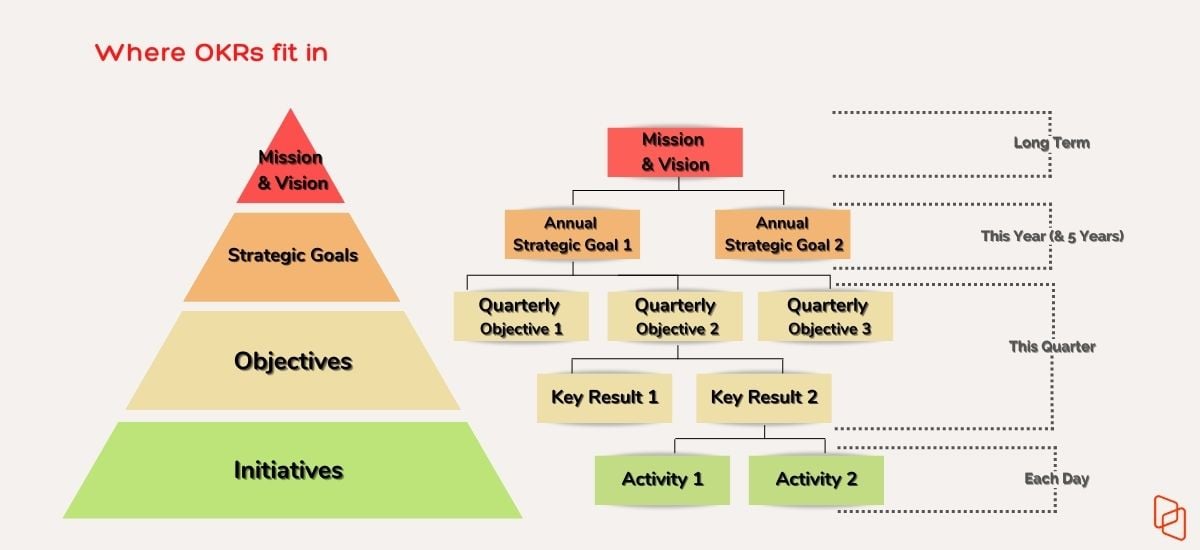
Who Created the OKR Methodology?
It is important to note that rule number one of OKRs is that… there is no rule number one! OKRs are the first truly crowd-sourced methodology. There is no one rugged prairie agency or thought leader that has created and commands what can and cannot be done around OKRs in business.
There is no one thought leader that developed OKRs. Sure, John Doerr wrote a book named “Measure What Matters” which has greatly popularized OKRs, but he's clear that he did not come up with the concept. As such there is no one to form and refine new ideas as they come to the space.
In addition, the dilemma is that John's book was not intended as a” how to” and therefore has proven very difficult for most organizations to follow and most software vendors to enable. In reality, there is no one source to say any of these ideas are right or wrong.
Further complicating the problem is that it appears that most of the OKR software Developers lack industry and real-world business experience. This has resulted in a cluster of tools that either try to replicate the stories from John Doerr’s book or merely copy what the other software vendors are providing.
What are OKRs in Agile?
OKR is an agile goal management method, while Scrum is an agile project management method. Both find their place under the “Agile” methodology and, when properly integrated with each other, can form a powerful framework for holistic agility.
OKRs support agile project planning because they can be reworked on a quarterly basis and can easily be adjusted to support changing needs. They’re similar to KPIs in that they are metric-based, but they represent aggressive goal-based metrics, instead of just measurements.
Deciding to adopt an OKR framework is not just about monitoring the data of the established objectives and key results, but this framework provides a way for entire organizations to align every day’s tasks to the company’s top priorities. OKRs allow a company to be fully transparent and avoid wasting time on tasks that won’t benefit or contribute to the company’s growth.
Why are OKRs Essential for a Business?
The OKR process helps improve individual goals, team goals, and company-wide goals. As John Doerr said in his previously mentioned book “Measure what Matters”: “Ideas are easy. Execution is Everything.”
So, simply put, the OKR methodology allows you to translate great ideas into an efficient execution while increasing productivity and employee engagement.
1. OKRs help you frame your Goals.
First things first: define your Objectives. An OKR objective is simply what you want to accomplish. It should be a short and precise statement that is action-oriented and inspirational.
Once you have your objective, is time to determine how you plan to achieve it. Setting 3-5 Key Results that best align with your plan to achieve the objective. The most important thing here is that Key Results should be specific, measurable, and time-bound.
2. OKRs allow you to Track and Measure Progress
The crucial part is to measure at the end of a determined period of time what was accomplished after setting your objectives and key results. The only way to improve and to verify if something is working out for your team and/or company is to measure success rate and improve performance. If you don't, you're basically playing a game of hit and miss, just praying that what you’re doing works, and you’re missing out on a great opportunity to learn and develop growth.
Essentially, what gets measured gets done.
3. OKRs let you reassess and make adjustments
It’s important to remember that OKRs are flexible, and they do not have to be set in stone. Within the OKR cycle, you should have OKR meetings to review and assess what’s working and what is not. You don’t have to hold on to objectives and/or key results that have lost their relevance or are turning out to be unattainable (at least for now).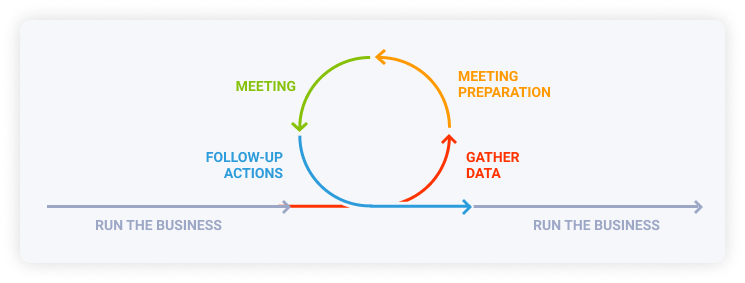
At the end of each OKR cycle, always look at your key results and determine whether they were accomplished or not. And reassess to verify if you need to make any changes or adjustments, either on the deadline or the level of ambition of the objectives.
Every time you review the success or difficulty to achieve your objectives, is an opportunity to revise your capabilities, and your areas of opportunity. With what you know you can continue to set more and more realistic goals.
Industries and Companies that use OKRs
Some of the companies that have adopted the OKR methodology include Google, Netflix, Amazon, Allbirds, and more.
%20(1).jpg?width=1020&name=Screen%20Shot%202022-07-25%20at%2011.50.20%20(1)%20(1).jpg)
Image by Manu Cornet.
OKRs, as deployed by Google, are great for helping employees make sense of organizational chaos... Do not assume that you need to set up OKRs as Google did... unless you have the same organizational design as Google! There are many ways to deploy OKRs so that they help your employees... Make sure that you use the right technique for your organization!
What are the benefits of OKRs?
OKRs (Objectives and Key Results) are a great tool, but they cannot do everything… or can they
OKRs are a great technique for taking your organization’s strategy and cascading it down to what teams and individuals need to do daily/weekly/monthly to achieve that strategy.
OKRs are taking technology companies by storm as they are (finally) putting the hard work of developers into context – so they can see how they contribute to their company’s success.
They have recently crossed the chasm into mainstream corporations as they effectively transform the huge corporate entity into manageable ‘bit-sized’ pieces in which meaningful work can get done.
In all organizations, they do a bunch of awesome things, including
- Creating alignment across the organization for better results with less effort.
- Committing departments, teams, and individuals to priorities and performance levels.
- Surfacing natural cross-functional teams for better execution.
- Tracking progress for accountability.
- Stretching the organization for amazing results.
- Improving Employee Engagement
%20(1)%20(1).jpg?width=800&name=Illustrative%20Self%20Care%20Infographic%20(printable)%20(1)%20(1).jpg)
Our field research has proven that there are six types of OKRs – Valuation, Navigation, Compensation, Calibration, Communication, and Regulation.
Types of OKRs
The whole idea of OKRs is that they are a Navigation tool. They help us make day-to-day decisions about “Do we turn left or right?” … “Do this or do that?”. As such, navigational OKRs need to use leading indicators. Key Results that predict future performance so that we can make decisions today to enable a better tomorrow.
Characteristics of a great navigational KR include:
- Relevant – The metric should be closely related to actual performance, across normal scenarios.
- Predictive – Provides insights into the most likely future outcome.
- Actionable - Covers areas that the associated person/people have the authority, competencies, and resources to act on towards delivering performance.
- Vivacity - Does the measure inspire, engage, and allow for team/individual contribution?
On the other hand, Compensation tools need to use lagging indicators. Indicators that accurately measure what has occurred, after all, it is appropriate that we get compensated for what has been accomplished, not what might be accomplished in the future. Not only that, but there are a number of other criteria for a “fare-deal” compensation system that would cause navigational OKRs to fail, including:
Compensation measures should be S.M.A.R.T. The “A” in SMART is “attainable”, but great OKRs are aspirational, they cause us to stretch – and are not intended to be attainable. Achieving just 70% would be great.
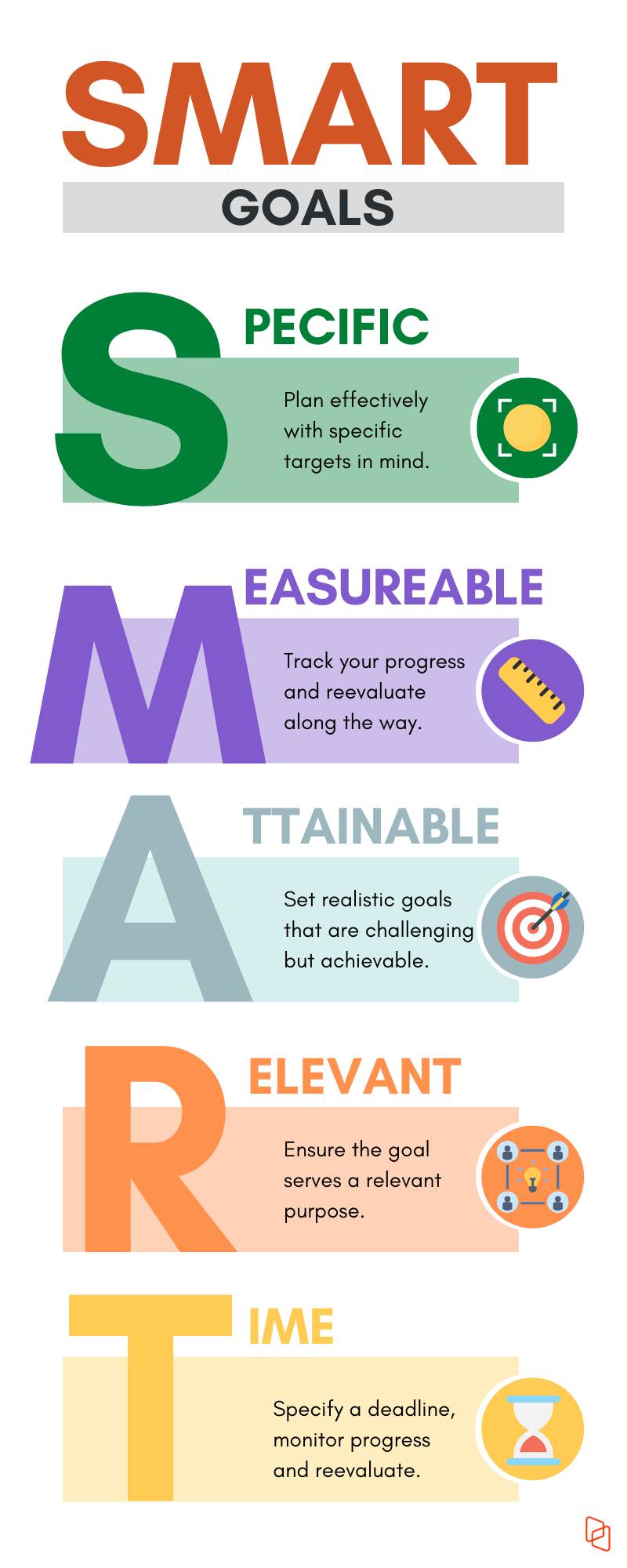
- Consistent across time – you cannot keep on changing one’s compensation metrics – they are usually frozen for the year, yet Key Results and targets are usually changed every quarter.
- Auditable – the numbers in your compensation system need to be validated by external sources, to ensure no one is ‘gaming’ the compensation system, yet OKRs are often softer measures that would fail an audit.
The issue is that the characteristics of great navigational KRs vs. those of great compensation KRs make it tough, but not impossible, to find KRs that pass both check-lists. But even if you could, the deal-breaker is the target. Best practices for OKRs are to use ‘stretch’ targets (‘aspirational’). These are targets that if you achieve even 70%, would be awesome. You cannot use these stretch targets as part of a “formula-based” compensation model because of the ‘elasticity’ of actual performance.
How to Write Good OKRs
Organizations can be disappointed if their OKRs are not delivering the benefits they’re supposed to. Sometimes organizations can find themselves performing significantly worse than before being introduced to OKRs!
It’s something we’ve seen several times. They found that:
- OKRs were seen to be a “To-Do List” with no clarity on which was more important.
- The scoring system left them baffled as to what performance made a difference.
- They found themselves bickering with each other around who was responsible for making process improvements, who was supposed to be consulted before changes got made, etc.
- Some OKRs seemed to be marketing slogans, and others were mathematical formulas, resulting in a rat-nest of confusing lists.
- Feedback was still too slow and too late to be of any value to teams and employees.
So, how to write good and effective OKRs?
How to Write Company and Team Objectives
1. [Verb] [Specific Noun] by [Target] in [Quarter No.]
Like square dancing, if the moves are called out, it’s much easier for us to all do the right thing. The mechanics of OKRs are simple. Objectives are expressed as [Verb] [Specific Noun]. For example, [Grow] [New Product Sales] or “Grow new product sales”. We like the specific noun to ensure the team is focused, and everyone can understand it. This way we are not mistakenly chasing sales from existing customers or the same products as last year.
The target part is easier – it should line up with your strategic plan, operational budget, or whatever commitments you have made to stakeholders. Ultimately, that target needs to be broken down to what you will be doing for each of the next few quarters, or whatever time frame you prefer.
Technically, OKRs are only for the next quarter, and at the end of the quarter, you create a new set of OKRs (or just KRs) for the next quarter. In reality, management needs to know your best guess as to what is going to happen each quarter headings toward that annual goal. Should they expect a huge leap in sales to happen in Q1, Q2, Q3, or Q4?
Now, when each quarter comes along, you’ll need to adjust targets for the coming quarter with the additional knowledge gained through the current quarter combined with new knowledge about the market, competitors, exchange rates, etc.
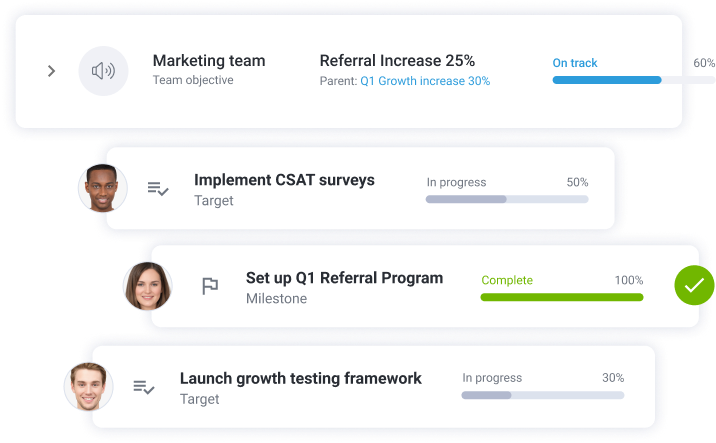
2. RACI
RACI is so 1960s - but everything old is new again! What is RACI, you say? One of the most used and least understood acronyms in business. RACI is a “role clarity” model. It attempts to describe the key roles in any process: Responsible, Accountable, Consulted, and Informed.
For every OKR, it will describe who is Responsible for doing that task (the job performer) and who is Accountable for making sure the process is continuously improved and delivers what is required from it. C stands for Consulted – who must you consult if you plan on changing the process. I is for Inform - who must you inform that you have made a change.
Using RACI makes sure that we do not have overlaps, meaning you think you are accountable for the process and can change it as you see fit, but I think I am accountable for it. Overlaps can lead to conflict as we both fight to change the process to match our desires. But, underlaps can be worse - you think I am accountable for it, and I think you are accountable. In the end, this means it never gets done.
RACI allows us to be clear on who does what in advance of problems, so even when problems occur we can react quickly and effectively. In some cases, you may develop your OKRs only to the team level. Someone should still be accountable within that team for the OKR, so you will assign the “A” to someone on that team.
Depending on the culture in your company, you can either skip the “C” and “I” or go the other way and add in more letters, such as “S” (RASCI) to capture the Support you need from other teams or departments.
3. Keeping Strategic Score
This hack is easy to explain, but harder to implement. Imagine if you could assign “strategy points” for everything you did. The more your activity enables the strategic goals, the more points you earn. Imagine that every week, day, or month you could see how many strategy points you earned. You could then figure out how to maximize points earned for your efforts.
These strategy points work at all levels – individuals, teams, departments – and corporate.
We call that the gamification of business.
4. Setting Priorities and Changing Them
Not all OKRs are created equally. Michael Porter says something like “strategy is more about what you stop doing then what you start doing”. We need to give clear instructions to everyone on what they should start doing and what they should stop doing - and guess what? OKRs are the ideal way to capture and communicate those priorities.
At some point, we need to understand leadership’s priorities for the top level Strategic Objectives. For example, is it more important that we get revenue growth from existing customers or revenue growth from new customers?
From there, we need a way to accurately cascade those priorities down and across the organization. So, for our example, to achieve sales growth from new customers, maybe Marketing’s highest priority is around identifying and targeting new customer segments. Sales’ highest priority is on quickly and effectively processing new customers. Product Development may need to identify and develop products which are of the greatest interest to those new segments. Each department has a different priority in contributing to the overall OKR.
The benefit of this cascade linkage is that everyone is aligned and working on the right things.
Later, if leadership needs to change the priorities, deciding the company needs to get more revenue from existing customers instead, we can all quickly see how our department, team, and individual priorities change based on that new direction. By adjusting OKRs we can swiftly change the organization’s direction.
Here’s what we have also discovered - no matter how hard leadership researches, discusses and considers their priorities, they will be at least partially wrong. Why? Because we never have complete knowledge and because our business world rapidly changes. The external market changes, our ability to execute changes, or any of a million unforecasted events will occur. Successful organizations need the ability to quickly change direction faster than their environments and competition.
The OKR system linked to your strategic priorities allows the organization to change direction faster than changing itself.
5. Coach, Mentor, Protect and Train
Our extensive experience with OKRs tells us that no matter how long your OKR team works in a room, they will never come up with the perfect collection of OKRs. This is not unlike learning to ride a bike… sooner or later you have to just hop on and use the skills you have to figure it out.
With OKRs, we generally suggest that it will take three quarters (nine months) for your team to build the culture and engagement needed in order to make your OKR solution self-sustaining.
Over those first nine months, and from then on, it is the job of leadership to nurture the OKR process. You must constantly show everyone how to use the OKRs to answer all company performance questions. You must constantly coach on how to use OKRs to problem solve, allocate resources, and work as a team. You must show them by example on how OKRs make their jobs easier and better aligned with the rest of the organization. You need to protect your team against those who would sabotage the old KR process or usurp it for their own benefits. And you must constantly train them on best management practices.
Like bringing up awesome children or training a puppy, this investment will pay you back in multiples of the effort you put in. But you have to put that effort in!
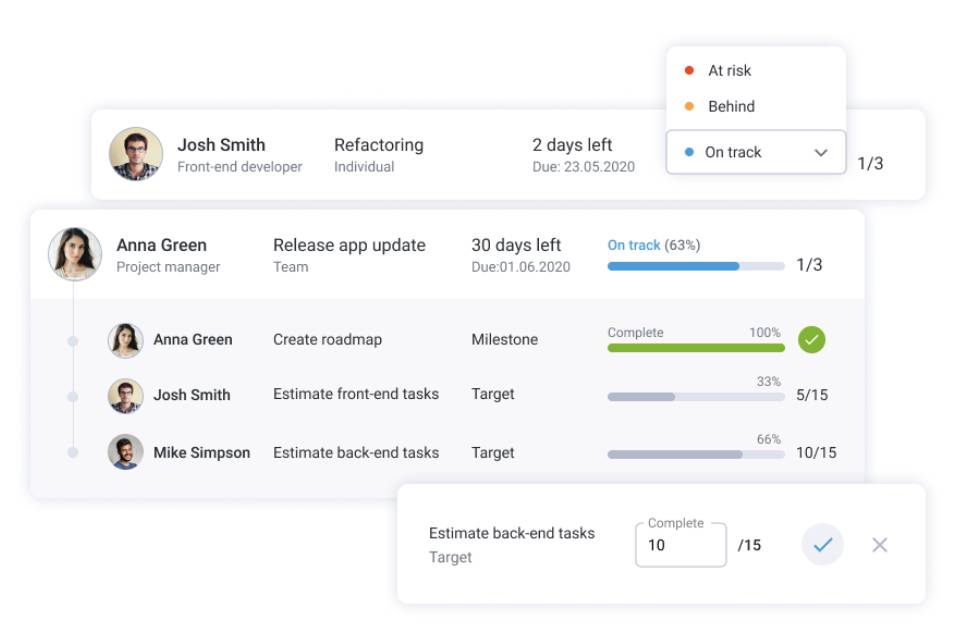
How to Write Key Results to an Objective
In their simplest form, Key results (KRs) answer the question: “What will we see more of, or less of, as we work on this Objective?”
As John Doerr describes them in his book “Measure What Matters”: “These are the benchmarks you’ll track on the path to hit your main objective(s). These act as goal posts to help assess your progress.”
General consensus is that;
- There should be 1-3 KRs that quantify success for each Objective.
- The KRs’ targets should be detailed by quarter.
- The KRs’ targets define the best possible results – not the most probable (so you will never achieve 100%),
- They help define where you will focus efforts because it creates the most value.
Indicators, not Diagnostic Measures
Consider your OKRs to be similar to the dashboard on your car. In your car, there are multiple extremely complex systems that get simplified for the driver. The dashboard present to you the important information you need, as a driver, to successfully use that vehicle.
Your OKR solution is the dashboard for your entire organization's activities. Your organization is made of multiple complex systems that need to be simplified and consolidated in this one view of the truth.
With your car, if an indicator turns red, such as your check engine light, you as the driver (AKA leader) know to go to the process expert (AKA Mechanic) who can do the assessment and provide you with an informed analysis of what action should be taken. Your mechanic will use many system-specific diagnostic tools to research the specific indicator that has turned red.
In your business, your OKR solution should operate the same way - it will provide leadership, and everyone else in the organization, with indicators about where they should be focusing their attention to achieve your objectives. In most cases, the OKRs are just indicators of where performance issues are occurring, and do not provide sufficient information to do any diagnostic work.
Once an OKR has triggered the need for further investigation, your process experts will go to their system of record, such as Hirebook, to assess the situation and provide an informed analysis of what is occurring.
KRs tend to be indicators, not diagnostic measures.
Types of KRs
Results typically come in four types:
- Milestones - reported as either the specific project Milestone to be achieved by quarter-end or the percentage of the quarter-end Milestone achieved.
- Target - be specific with the Target you are looking to achieve such as sales revenue or the number of new customers.
- Target range - the range of acceptable performance, such as order fulfillment within 5 days plus or minus one day.
- Budget or burn down - KRs where you are allocated a certain number of consumable resources, such as money, and the report on how fast that is consumed. This is often used in agile projects.
.png?width=739&name=OKR%20(1).png)
KR Cadence
Departments in your organization, like gears in a watch, move at different speeds. It may be appropriate for some of your departments to meet daily, others weekly, and others bi-weekly on their OKRs. There is no reason to mandate that every department needs to meet with the same cadence, but you should agree when throughout the quarter everyone updates their KRs.
These days we recommend that every department meets at least weekly and that the company has cross-organization okay meetings at least once a month.
As a general rule, the more pressure an organization is under, the more frequently your team will need to meet.
How to Track OKR Results?
There are numerous ways to measure OKRs, but when companies start using a goal-setting framework based on OKRs, they usually start tracking them using spreadsheets or other processes that are more manual. When starting using these processes like Excel, Google Sheets, etc, it doesn’t take long to realize that these methods are quite limited, and they may work fine at first, but eventually, they become tedious and end up taking a lot of company time just to fill the information, which is not profitable in the long run.
Manually tracking OKRs practically removes all of the benefits that the OKR methodology brings to an organization. The company’s objectives and goals should be on everyone’s top of mind and aligned with everyone’s daily tasks. When using an OKR software, this can be accomplished by providing one universal location where everyone’s work and contributions can be documented.
When manually tracking OKRs, inserting the progress data of objectives and setting up reports takes a lot of time and you’re prone to make mistakes. It also complicates the alignment of goals both horizontally and vertically across teams and the organization.
Spreadsheets aren’t Enough
When companies start adopting the OKR methodology they usually start using spreadsheets as their OKR tool, which may work fine at the beginning when testing OKRs out with a small group of people and sourcing a small amount of data. But when the time comes to assign OKRs across the entire company, the big amount of data and documents that have to be shared and updated constantly becomes something unmanageable.
This can lead to a lack of successful follow-up and follow-through on the process, and OKRs become tedious instead of a helpful tool that provides strategic focus.
OKRs are supposed to improve cross-functional alignment, accountability, and collaboration; when you try to track OKRs using multiple documents, they become another place for employees to update their progress, which takes time and decreases motivation, especially if they’re already using other systems that automate updates for different purposes.
Documents like spreadsheets remain separate from workflows, therefore employees may fail to fill in their updates on time, preventing the rest of the company to stay aligned and on track with their goals. Each employee's goal contributes to the team and organizational goals, experiencing this lack of transparency because of an outdated way to track progress prevents team members from seeing where they are in reaching broader goals.
Not having an easy way to visualize progress can take a bigger toll on other activities, like managing one-on-ones or coaching sessions between managers and employees can become harder if managers are not up to date with their employees' progress.
Cascading Goals
John Doerr (“Measure What Matters”) helped put OKRs on the map, and he noted that “cascading makes an operation more coherent”. A company developing top-level OKRs to guide the business over a specific period of time, needs to cascade goals to different teams, allowing employees to make these objectives a reality. But cascading goals using a manual tracking system is quite difficult and requires employees to individually track and monitor their goals’ progress. This in turn causes a lack of transparency, which is critical to the success of OKRs.
As we said, this process may seem “fine” at first when dealing with a small group of people with a small number of objectives, but one of the great benefits of using OKRs is that they are flexible and repetitive, they can be updated constantly and re-aligned when environments, goals, and objectives change. Now imagine that your OKRs are set company-wide but suddenly a change in the market requires you to change certain objectives, just thinking about changing numerous spreadsheets to manually re-design your OKRs sounds like an overwhelming task.
When goals are tracked manually there is a lack of insights and transparency. It becomes difficult to understand how their work aligns with other teams, know how good the progress is towards achieving certain goals, and how broader business objectives are being achieved.
To manage OKRs at a bigger scale and gain their full benefits, it’s required to have smarter and more efficient processes that go beyond manual tracking. A simple and effective way to manage the company hierarchy, support team structures, and alignment is a critical thing.
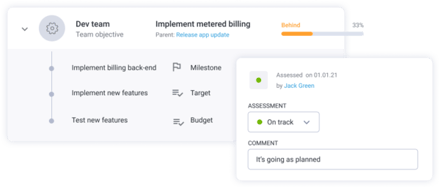
Anatomy of a Key Result:
- Metric
A metric is what makes the Key Result “measurable”. Some usual metrics used for products or customer success include NPS (Net Promoter Score) or MAU (Monthly Active Users). SaaS companies focus more on MRR (Monthly Recurring Revenue and Churn Rate. Production companies mostly use operational metrics.
Setting the metric of a KR is where most people get somewhat confused. Make sure you’re able to track the metric you want before you assign it to a Key Result; if you don’t clarify this you won’t be able to see your progress accurately.
- Title
Most of the benefits that the OKR methodology offers, like better alignment across the organization and transparency, require that the OKRs themselves are clear and understandable. So, the Key Result Title basically englobes and communicates in a transparent way the result you want to achieve.
The Title also puts each value in perspective. For example, if your KR is to “get new customers”, the metric here is the amount of customers, but you can make your title more specific by adding a certain amount of new customers you want to get, or even challenge yourself or your team by setting a title like “double the amount of customers”.
- Start and Target Value
A Start Value is simply the value your metric has at the start of the determined time period you set to achieve each KR. A Target Value is the value that you want that metric to have at the end of that determined time period.
Establishing the right target value could be difficult if you don’t have a certain parameter yet. In that case you just need to have sort of a “trial period” (like a couple of weeks) to collect that parameter. Maybe the data collected in that time won’t be specific enough, but it can only get more specific through time and prove to you how fast you and/or your team achieve those KRs.
OKR Grading
Rick Klau, partner at Google Ventures, recommends scoring Key Results between 0.0 to 1.0, although that is not mandatory, and 0% to 100% or ‘A’ to ‘F’ as useful grading options. But in the end you can score KRs using any format that works best for you and your organization.
To calculate a score, you have to divide the target set by the final result. Using the example above, if your team’s KR was to “get 100 customers” but they only got 50, their final score would be 0.5, but if they got 20, the score would be 0.2. Having this score we can assign a grade to the Key Result.
When grading a Key Result, having a score of 0.6 to 0.7 may feel like barely accomplishing it. If a team or single employee has that average score they’re probably just meeting what is asked of them and pushing themselves a little. But of course what we want is to go above and beyond and get a score of 0.8 or higher! It’s important to know that a low score (0.2 - 0.4) doesn’t always mean that your employees are not working hard enough, a low score should be looked into and reviewed to see what is preventing your employees from scoring higher. Maybe the problem is not them, maybe the KR needs to be tweaked.
If your Key Results are not exactly measurable by numbers, but their targets are more date-focused like “print the new magazine issue by *date*” or “hire new IT analyst by *date*”, then the scoring of this KRS will most likely hit the 1.0 mark pretty often.
Reviewing OKR Scoring
If your employee or your team didn’t go so well on their KRs, don’t worry! The worst that could happen is finding out you need to adjust them and this is especially common when first introducing the OKR methodology into your organization.
Start by asking “what went wrong?”, “were there blockers we didn’t identify?”, “was there an unusual situation?”, “what could we have done differently?”, “what else can we do?”. There is no one right way to do OKRs, but you need to find out the best way to take advantage of them, and learning from failure is an opportunity to figure that out!
To make this OKR process faster, review teams’ and company wide OKRs every certain amount of time, like every quarter for example. Have your managers or every team’s head explain their grades and ask them what they plan to do differently to get closer to the target next quarter.
Determining OKR Success
To understand your OKR reporting and determine their success, Rick Klau suggests that one way to assess an entire OKR is to average the Key Results scores that belong to one Objective. This will tell you how well the KRs for an Objective were completed. But, it is possible that KRs scored great and still fail at the completion of the Objective.
Even though Key Results may be completed, the Objective should be reviewed. It can also happen that the KRs don’t affect the Objective, or the KRs didn’t impact as expected considering the time, money and effort invested.
If your organization has an ongoing Objective across every month or quarter like “print the magazine by *date*”, you can try different KRs every time span to learn what tasks and activities are more effective to reach the goal. Remember that it’s ok to experiment!
You can go in depth on determining if your OKRs are good or bad by clicking here.
OKR Examples
As we stated before, OKRs support agile project planning since they can be reworked on a quarterly basis and can easily be adjusted to support changing needs. They are metric based, but they represent aggressive goal-based metrics, instead of just measurements. Here are some OKR examples:
Objective - “Successfully implement the weekly newsletter”
-
KR1 - Finalize the content strategy, key messages, and topic structure for the next 6 months
-
KR2 - Grow subscriber base at least 5% per week, getting to 50000 readers
-
KR3 - Increase the CTR% to above industry average 3.5%
Objective - “Increase recurring revenues”
-
KR1 - Reach monthly recurring revenue ($ MRR) of $250000
-
KR2 - Increase the share of monthly subscriptions vs one-time contracts sold to 85%
-
KR3 - Increase average subscription size to at least $295 per month
-
KR4 - Increase annual renewals to 75%
Objective - “Achieve record revenues while increasing profitability”
-
KR1 - Hit quarterly revenue of over $100000
-
KR2 - Start sales in 2 new countries and achieve first quarter revenues totaling over $100000
-
KR3 - Increase gross profit % margin from 23% to 54%
Objective - “Refactor our old user management module”
-
KR1 - Survey 5 external API users regarding issues with our authentication
-
KR2 - Discuss the user management code usage with 5 engineers having used it in production
-
KR3 - Rewrite and launch a new version of our user management module
-
KR4 - Rewrite the API user authentication for the new version
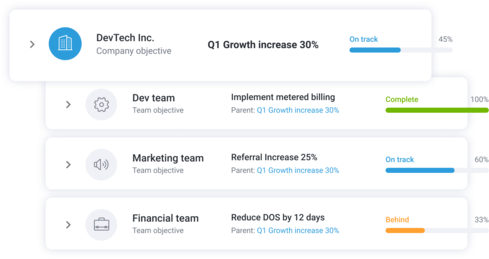
There is no universal OKR template, but we invite you to read our article “Using a North Star Goal to set OKRs” and download our template!
Common OKR Mistakes
Until you use an OKR, you have no idea if it is the best OKR ever or the worst OKR ever. (Remember Schrödinger's Cat? Until you open the box, you have no idea if the cat is alive or dead - so it is both alive and dead. See footnote)
We have seen so many organizations take a painfully long time to develop their OKRs. It is as if they think the answer to 'the best OKR' is on the walls of their meeting room! (It is not!). In fact, in our experience, the longer it takes to build your OKRs, the worse they become. Sometimes you just have to stop thinking so hard!
What's worse is that people in the organization seem to take sides - some say the cat is dead and others vehemently argue the cat is alive. Or rather, some say this is the best OKR ever and others argue that it is the worst ever. But your skills as a debater have little to do with the viability of that OKR.
The only way you can tell if your OKRs are good or not, is to use them.
We sometimes get the feeling that organizations don't want to know if they have the right OKR - they want Schrödinger's OKR that is both the best ever and worst ever. Over the years we have formed a list of hypotheses on why organizations might not want to know if it is alive or dead…
- Maybe they feel pride in having built them and don't want the feeling tarnished by what they might find when they turn them on.
- Maybe they think OKRs are like their old business planning process - you do all this great thinking, but there is nothing to "turn on" - you just look at it once a quarter in your forced QBR.
- Maybe they are afraid if they "make strategy everyone's everyday job". I mean, what if everyone owned the strategy, was aligned to it, and focused their efforts on it...BUT it was the wrong strategy?
- Maybe the culture of the organization puts too high a price on failure - people do not want to turn anything on until they are certain it is right.
- Maybe they don't know how to turn their OKRs on.
Regardless of the reason for hesitating, don't! You will never know how good or bad your OKRs are until you use them.
OKRs are like riding a bike - you cannot learn to ride a bike in a classroom, you cannot build a great OKR in the Boardroom.
You might need a few bandaids, but in the end, you'll have far more fun riding that bike than writing more flip charts.
How to Implement OKRs in your business?
Across hundreds of organizations going through an OKR framework journey, we have found most organizations can codify their strategy, cascade it to meaningful company level Objectives and find reasonable Key Results - what derails them is the organization's culture/motivation and OKR-related capabilities.
We have found using BJ Fogg's behavior model provides a great tool to assess and correct these components.
The fastest, Cheapest, Best – and easiest path to OKR success is through motivating, educating, and triggering OKRs in the entire company.
The BJ Fogg Behavior Model
The Fogg Behavior Model (FBM) highlights three principal elements as the drivers of behavior: Motivation, Ability, and Prompt. He talks about "Prompts" as efforts to encourage individual and team OKR success.
This framework has been widely applied and proven to be valid in multiple situations outside of OKRs - but we have gained a good amount of experience in the OKR methodology and have been very pleased with the insightful and dynamic thinking it provides.
Here are four things you can notice right away about the Fogg Behavior Model from looking at the graph:
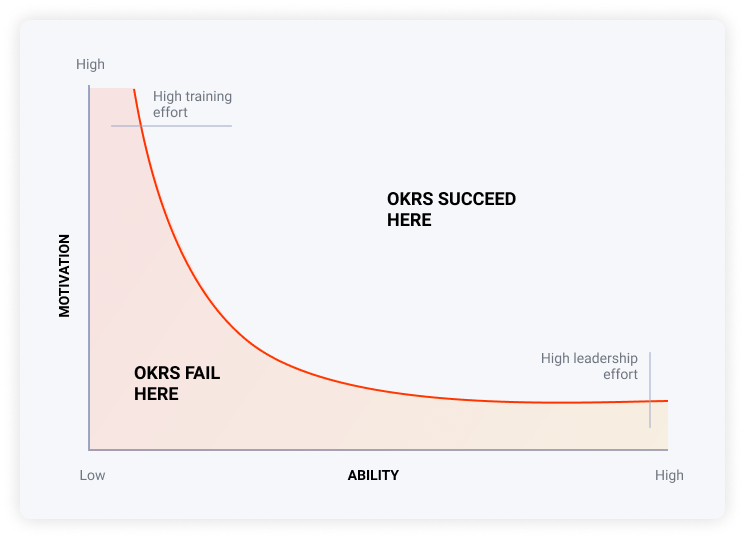
a) As a person’s motivation and ability to implement OKRs increases, the more likely it is that they will use OKRs.
b) There’s an inverse relationship between motivation and ability. The easier it is to implement OKRs (Objectives and Key Results), the less motivation is needed to use them. On the other hand, the harder they are to implement, the more motivation is needed.
c) The action line — the orange curved line — lets you know that any behavior above that line will take place if it’s appropriately triggered. At the same time, any behavior below the line won’t take place regardless of the trigger used. Why is that? Because if you have practically zero motivation to use OKRs, you won’t regardless of how easy it is to do. At the same time, if you’re very motivated to use OKRs, but it’s incredibly difficult to do, you’ll get frustrated and you won’t act.
d) If you want OKRs to succeed, look for ways to boost motivation or ability (or both). In other words, aim for the top right of the model.
Prompts
So all this is fine – two-axis charts that make sense.
Now comes the tough part. To make change happen, we need a prompt – something to cause us to want to implement OKRs. In the top right corner – high motivation and high ability, we do not need much of a prompt. As we fall off in either motivation or ability, we need a high-force prompt to make the change happen.
In the OKR context, the higher the motivation, the lower ability the organization needs to succeed with OKRs. The opposite is also true: The higher the ability, the lower the motivation needed to succeed with OKRs.
We actually end up with an “action curve” that looks like this line:
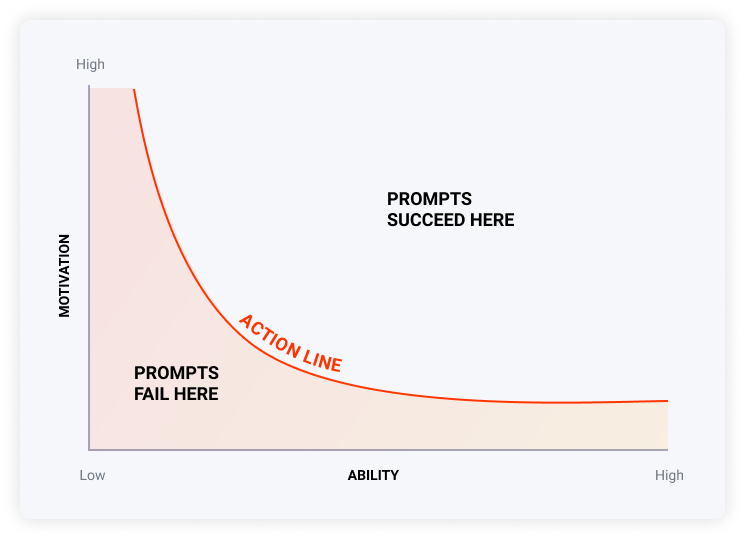
In fact, it creates a “likelihood of OKR success curve”.
A prompt is best described as a call to action. A prompt could be as simple as leadership asking us to build an OKR solution. A more significant prompt could be ongoing OKR process meetings, even larger, rewards for getting the OKR system running or accomplishing a key result, etc.
So let’s now dig a bit deeper into OKR prompts and see why they matter in OKR implementation success.
Internal vs. External Prompts
The most important distinction to make with prompts is the difference between external and internal prompts.
External prompts are anything in your environment that tells or reminds you to do something. It could be a post-it note, a billboard, or a phone notification. It is something external nudging you to do something.
For OKRs it could be the automated reminder from your OKR software, your weekly performance reviews meeting, or an updated scorecard.
Internal prompts are any feeling or emotion that tells or reminds you to do something. Typical examples of this are feelings of hunger or thirst. It is some signal from your body nudging you to do something.
In the OKR world, it becomes your daily performance habit, your desire to see how you and your team are performing on their objectives, your need to update your team on your progress, and any key result you’ve met.
Types of External Prompts
Stanford professor BJ Fogg has identified the following three types of external prompts.
Spark: Helps when you have the ability, but not the motivation. An example of this is a reminder to go to the dentist. The reminder sparks you to get ready for the appointment, even if you are not currently motivated to go.
Facilitator: Helps motivated people who lack the ability to complete a behavior. The facilitator prompts to make the action easier or at least seem easier. A typical example of this is the instructions to help you write your OKR analysis.
Signal: Helps people who are both motivated and have the ability to complete a behavior. The primary purpose of the signal trigger is to remind us of something we want to do. An example is a calendar reminder for your next OKR meeting.
Master the Force
When you start understanding this concept, you begin to realize that there are prompts all around us. Our alarm clock, our Facebook notifications, our inbox alerts, our hungry stomachs, and the list goes on. Hundreds of prompts gently nudge us along and shape our OKR routines.
Part of making a great trigger is understanding the context (spark, facilitator, and signal) and then determining a suitable frequency of how often the prompt should occur. The mix of prompt type and frequency is a fine art…in every instance except OKRs. In the OKR world, it is pretty easy to sort out your organization’s ability and motivation levels. From there it is a short step to sort out the best prompt and frequency.
So this is where this story ends – to make sure your OKR solution works – faster, cheaper, better, and easier, all you have to do is:
-
Assess your organization’s OKR motivation level,
-
Assess your organization’s OKR-ability level, and
-
Set the right prompt strategy.
Benefits of an OKR Software
An objective management suite or an OKR tracking system allows you and your team to focus on their goals from one space instead of using multiple spreadsheets or other tools. In that space, everyone is able to see everyone’s progress and, therefore, company-wide progress. Keeping an eye on how everyone’s performing gives you the opportunity to see if someone needs help if someone is over achieving or if a team is maybe struggling to keep on track. It also gives your employees the chance to see how their work and every task they perform impact the entire organization, either positively or negatively.
By defining clear goals that push you and hold you accountable, you can stay focused on the things that matter most.
One of our goals at Hirebook is to rapidly innovate our SaaS product so that all of our customers get immediate access to the rich functionality that we will be bringing to the market. It's our belief that by continually leading the market we will attract loyal customers who will help us innovate, test, and bring to the market remarkable new functionality to help all companies and employees to thrive.
It is our intention to bring the following categories of functionality into this employee engagement space:
- OKRs
- HR best practices (learning, role clarity, organization design, recognition, rewards)
- Values and Culture
- Working environments and technology
- Purpose and Higher Objectives
It is important to note that this is more than just objectives and key results. This is about enabling systems that generate Employee Engagement, incredible performance, and achieving all the higher-level goals and purposes of the organizations in which we work. Our goal is to help society thrive.